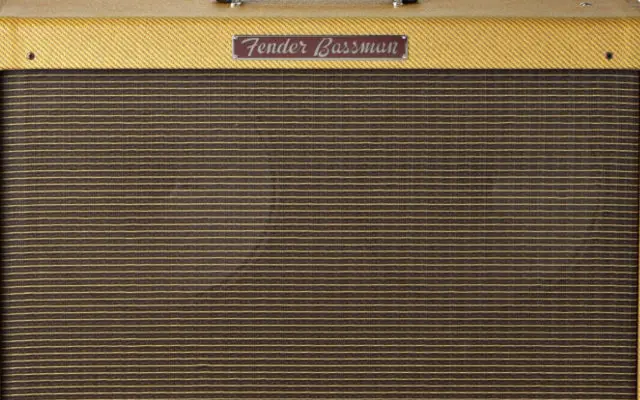After Leo Fender introduced his revolutionary new Precision electric bass in 1951 he had to come up with an amplifier that could handle the new instrument’s low end power.
The first Fender Bassman was released in 1952, it featured a 15″ speaker and 26 watts of all tube power. It basically was a guitar amp with a little more low end response, but it set the stage for all bass amps to come that would literally change music forever.
By today’s standards that seems vastly underpowered but you have to remember that the electric bass was replacing the acoustic upright bass so the first Fender Precisions sounded huge through the Bassman.
Initially the Fender Bassman suffered from a problem that would plague many early bass amps of the day….blown speakers. The powerful new bass guitar was simply too much for the guitar speakers that were being used in the first bass amps. A new speaker had to be developed that could handle the high output and low frequencies of Leo’s Precision Bass.
After several redesigns Fender came out with 40 watt 4×10 tweed open back cabinet with Jensen P10R speakers and the famous chicken head control knobs. These amps were much better at handling the power of a bass and produced better tone and gain.
Ironically the tweed Fender Bassman will probably be best remembered as a great guitar amp. Guitar players, especially blues musicians absolutely loved the tweed Bassman. The Fender Bassman gave them a warm fat tone and smooth overdrive no other guitar amp of the era could match. In fact when Fender reissued the 59′ tweed Bassman they advertised it as a guitar amp rather than a bass amp
By the early 1960’s Fender had phased out the tweed Bassman line and introduced new bass amps. The Brownface, Blackface, and Silverface bass heads now had tolex covering instead of tweed and no longer came attached to a speaker cabinet like the old combos. These heads could be matched up to various Fender cabinets depending on what speaker size and arrangement the bassist desired
Fender still offered combo bass amps but most were sold as lower end budget models. The newer bass heads featured increased power with more headroom and had a huge influence on bass amp design.
By the late 1960’s other companies like Ampeg and Acoustic had become serious competitors to Fender, releasing their own powerful stage bass amps. In 1969 Fender introduced their Super Bassman head which featured 100 watts and was usually paired with 2×15 cabinet.
Fender Bassman amps had their own special sound, which made them stand apart from other brands. Most of this was to due to their unique tube circuit designs and cabinet construction.
Changes
The Bassman series continued to evolve throughout the 1970’s with increasingly more powerful and bigger amplifiers. Soon solid state amps started to emerge in the bassman line, offering more power, less weight and lower cost.
Unfortunately these new transistor amps left a lot to be desired in the tone department. Few bass players cared for the new solid state technology as they tended to sound dry and sterile. It wasn’t really until the 1980’s when solid state bass amps started to gain popularity, thanks in part to better technology and a trend towards a cleaner, more transparent bass sound.
Today Fender still produces the Bassman amp line and offers many different products. Massively powerful solid state heads, small combo amps, high powered combo amps, hybrid tube amps and even all tube bass heads that can handle the biggest venues.
Still some bassists, myself included will always be drawn to the older classic Bassman designs. Not as powerful or clean sounding as today’s amps but they have much more character and vibe to their tone.
